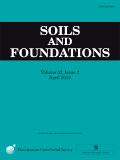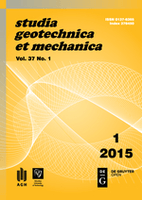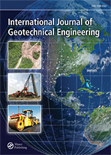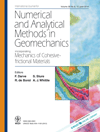
International Journal of Physical Modelling in Geotechnics
Scope & Guideline
Transforming research into practical geotechnical applications.
Introduction
Aims and Scopes
- Centrifuge Modeling Techniques:
Focuses on the development and application of centrifuge modeling to simulate geotechnical problems, allowing for the study of scale effects and the behavior of soil and structures under controlled laboratory conditions. - Soil-Structure Interaction:
Investigates the interactions between soil and structural elements, exploring how different materials and loading conditions affect performance and stability. - Experimental Geotechnics:
Promotes innovative experimental techniques and methodologies for testing soil and foundation systems, contributing to improved design practices and understanding of geotechnical phenomena. - Geotechnical Applications:
Addresses a wide range of geotechnical applications including foundations, retaining structures, slope stability, and underground constructions, providing insights for both theoretical and practical advancements. - Environmental and Sustainability Considerations in Geotechnics:
Explores the implications of geotechnical practices on the environment, including the sustainability of materials and methods used in construction and land development.
Trending and Emerging
- Cyclic Loading and Dynamic Response:
There is a growing emphasis on understanding the effects of cyclic loading and dynamic response of foundations and soil structures, especially in seismic-prone areas, highlighting the importance of resilience in geotechnical design. - Innovative Foundation Systems:
Research on advanced foundation systems, such as suction bucket foundations and energy piles, is trending, reflecting the industry's push towards more efficient and sustainable foundation solutions. - Environmental Impact and Mitigation Techniques:
Emerging studies focus on the environmental impacts of geotechnical practices, including liquefaction mitigation and the use of geofoam barriers, indicating a broader concern for sustainability and ecological effects. - Smart Geotechnical Systems:
The integration of smart technologies, such as sensors and monitoring systems in geotechnical applications, is gaining traction, aiming to enhance the performance and safety of structures through real-time data. - Geotechnical Challenges in Climate Change:
Research addressing the impacts of climate change on geotechnical engineering, such as soil behavior under altered hydrological conditions, is increasingly relevant, reflecting the need for adaptive engineering solutions.
Declining or Waning
- Traditional Soil Testing Methods:
There has been a noticeable decline in the publication of studies focusing solely on traditional soil testing methods, as the field shifts towards more innovative and complex experimental setups such as centrifuge and numerical modeling. - Static Analysis of Soil Structures:
Research concentrating on static analysis without considering dynamic effects has decreased, as the recognition of dynamic loading conditions (e.g., seismic, cyclic) becomes more critical in geotechnical engineering. - Basic Soil Mechanics Studies:
Papers focusing on fundamental soil mechanics principles without application to real-world problems or advanced modeling techniques are becoming less common, as researchers increasingly seek practical applications of their findings.
Similar Journals

Soils and Foundations
Connecting researchers and practitioners in geotechnical advancements.Soils and Foundations, an esteemed journal published by the Japanese Geotechnical Society, has established itself as a pivotal platform for innovative research in Civil and Structural Engineering and Geotechnical Engineering. With an impressive impact factor reflected in its Q1 quartile ratings for both disciplines, the journal provides critical insights that foster advancements in the understanding of soil behavior and foundation design. Since its transition to Open Access in 2020, Soils and Foundations has broadened its reach, ensuring accessible dissemination of knowledge to researchers, students, and professionals globally. With a rich history dating back to its inception in 1960, the journal continues to uphold a high standard of scholarly excellence, ranking within the top percentile in Scopus across geotechnical engineering fields. This commitment to quality and accessibility makes it an essential resource for anyone engaged in the vital areas of soil mechanics and foundation engineering.

Geotechnique Letters
Advancing Geotechnical Frontiers.Geotechnique Letters is a prestigious journal published by Emerald Group Publishing Ltd, with a focused dedication to advancing the field of geotechnical engineering and engineering geology. Since its inception in 2011, the journal has rapidly established itself as a leading platform for disseminating high-quality research and innovative practices, earning a stellar Q1 ranking in both Earth and Planetary Sciences (miscellaneous) and Geotechnical Engineering categories as of 2023. With an ISSN of 2049-825X and E-ISSN 2045-2543, this journal captures vital insights and cutting-edge developments that cater to researchers, industry professionals, and students passionate about geotechnical challenges. Although it operates under a subscription model, the journal offers options for authors to publish their work—enhancing accessibility for those seeking to share knowledge within the community. The Scopus rankings place it comfortably within the top echelons of its field, affirming its importance and influence in shaping the future of geotechnical research and practice. With converged years extending to 2024, Geotechnique Letters is positioned as an essential resource for anyone looking to stay atop advancements and discussions in geotechnical sciences.

COMPUTERS AND GEOTECHNICS
Leading the Way in Computational Geotechnical Advancements.COMPUTERS AND GEOTECHNICS is a premier scholarly journal published by Elsevier Science Ltd, devoted to advancing the intersection of computer science and geotechnical engineering. With an impressive impact factor and categorically recognized as a Q1 journal in both Computer Science Applications and Geotechnical Engineering as of 2023, it stands at the forefront of research in its field. The journal has maintained a remarkable reputation since its inception in 1985, providing a dynamic platform for disseminating cutting-edge research, technological advancements, and innovative methodologies related to the application of computer science in geotechnics. Researchers, professionals, and students benefit from its rigorous peer-review process and high-quality publications, which demonstrate practical applications and theoretical foundations necessary for the relevant industries. Renowned for an extensive global readership, COMPUTERS AND GEOTECHNICS plays a critical role in fostering collaboration and development in tackling complex geotechnical challenges through computational methods, all while contributing to the broader understanding of environmental interactions. This journal provides essential insights and is instrumental for those at the cutting edge of this evolving discipline.

Studia Geotechnica et Mechanica
Exploring the Mechanics of Materials for Tomorrow's InfrastructureStudia Geotechnica et Mechanica is a distinguished academic journal dedicated to the vital fields of geotechnics, civil engineering, and materials science. Published by SCIENDO, this Open Access journal has been facilitating unrestricted access to research since 2012, allowing for wide dissemination of innovative findings and methodologies. Based in Poland, it contributes significantly to the scholarly community by providing a platform for the exchange of ideas, techniques, and advancements relevant to Civil and Structural Engineering, Geotechnical Engineering, and related disciplines. With an increasing emphasis on applied research, Studia Geotechnica et Mechanica is classified in various quartiles, demonstrating its emerging influence in fields such as Computers in Earth Sciences and Mechanics of Materials. The journal is indexed in Scopus, showcasing its commitment to maintaining high academic standards. By publishing peer-reviewed research articles, this journal is essential for researchers, professionals, and students looking to stay at the forefront of developments in these critical areas of engineering and science.

International Journal of Geotechnical Engineering
Advancing Geotechnical Knowledge for a Sustainable FutureThe International Journal of Geotechnical Engineering, published by Taylor & Francis Ltd, is a leading academic platform dedicated to advancing knowledge and research in the field of geotechnical engineering, environmental engineering, and soil science. With an ISSN of 1938-6362 and an E-ISSN of 1939-7879, this journal has established a credible presence since its inception in 2007, reflecting its commitment to academic excellence through rigorous peer-reviewed research. Ranking in the Q2 quartile across several categories—including Environmental Engineering and Geotechnical Engineering—this journal boasts impressive Scopus rankings, placing it among the top publications in its disciplines. The journal seeks to foster a deeper understanding of soil behavior, geotechnical processes, and their environmental impacts, making it an essential resource for researchers, professionals, and students alike. While it operates under a subscription model, the wealth of knowledge and innovative findings disseminated within its pages are indispensable for anyone engaged in this vital field. With an expanding focus on interdisciplinary research and practical applications, the International Journal of Geotechnical Engineering continues to play a pivotal role in shaping the future of engineering practices worldwide.

Bulletin of Engineering Geology and the Environment
Unveiling the complexities of our environment through expert research.Bulletin of Engineering Geology and the Environment, published by SPRINGER HEIDELBERG, is a leading journal dedicated to the fields of Geology, Geotechnical Engineering, and Engineering Geology. With an impressive impact factor placing it in the Q1 category for both geology and geotechnical disciplines, this journal is recognized for its significant contributions to the knowledge and application of engineering geology practices. Since its inception in 1984, the Bulletin has provided a platform for researchers and professionals to share cutting-edge research, case studies, and innovative methodologies relevant to the challenges of understanding and managing geological environments. With a robust Scopus ranking—#32/321 in Geology and #43/229 in Geotechnical Engineering—this journal is an essential resource for academics and industry leaders alike, striving to advance the environmental engineering field. For those interested in accessing the latest research and developments, the Bulletin fosters a collaborative and informed scholarly community.

INTERNATIONAL JOURNAL FOR NUMERICAL AND ANALYTICAL METHODS IN GEOMECHANICS
Exploring the Frontiers of Numerical and Analytical MethodsWelcome to the International Journal for Numerical and Analytical Methods in Geomechanics, a prestigious publication dedicated to advancing the fields of geotechnical engineering and computational mechanics. Published by Wiley in the United Kingdom, this journal has been at the forefront of research since its inception in 1977 and continues to provide a vital platform for disseminating innovative methodologies and analytical approaches through 2024. With an impressive impact factor reflecting its excellence, the journal consistently ranks in the Q1 category across multiple domains, including Computational Mechanics, Geotechnical Engineering, and Engineering Geology, making it a key resource for specialists seeking to keep informed on important developments in these areas. Although it does not offer open access, the journal remains highly regarded among researchers and professionals for its rigorous peer-review process and commitment to scientific integrity. As a vital contributor to the field, International Journal for Numerical and Analytical Methods in Geomechanics invites researchers, professionals, and students to explore its comprehensive studies and to advance knowledge at the intersection of numerical analysis and geomechanics.

Geotechnical Engineering
Fostering Community Engagement in Engineering ExcellenceGeotechnical Engineering, published by the Southeast Asian Geotechnical Society, is a prominent journal dedicated to the field of geotechnical and civil engineering. With its ISSN of 0046-5828, this journal serves as a vital platform for researchers and practitioners to disseminate innovative findings and explore new methodologies within the discipline. Although currently listed in the Q4 quartile across both Civil and Structural Engineering and Geotechnical Engineering categories, Geotechnical Engineering is committed to fostering rigorous scholarship and community engagement in the dynamic field of geotechnical sciences. The journal covers a wide range of topics, providing an important resource for the engineering community. While it does not offer open access, it facilitates significant contributions that enhance the understanding and practice of geotechnical engineering in Southeast Asia and beyond, underscoring its vital role as a knowledge hub for researchers, professionals, and students alike.

GEOTECHNICAL TESTING JOURNAL
Exploring the Depths of Earth Science and EngineeringGEOTECHNICAL TESTING JOURNAL, published by the American Society for Testing and Materials, is a premier peer-reviewed journal dedicated to the advancement of geotechnical engineering and engineering geology. With an ISSN of 0149-6115 and E-ISSN 1945-7545, this journal has been a cornerstone in the field since its inception in 1978, spanning volumes released until 2024. Ranked in the Q2 category of the 2023 journal metrics, the journal stands as a significant contributor to Earth and Planetary Sciences, particularly in geotechnical applications, as evidenced by its Scopus rank of #102 out of 229, placing it in the 55th percentile across the database. Offering a wealth of empirical research, technical notes, and innovative practice insights, the GEOTECHNICAL TESTING JOURNAL aims to bridge the gap between theory and practical application, making it an invaluable resource for researchers, professionals, and students eager to contribute to and advance the field of geotechnical engineering.

SOIL DYNAMICS AND EARTHQUAKE ENGINEERING
Bridging Disciplines for a Safer, More Resilient FutureSOIL DYNAMICS AND EARTHQUAKE ENGINEERING is a premier academic journal published by ELSEVIER SCI LTD, focusing on the intersection of civil and structural engineering, geotechnical engineering, and soil science. Since its inception in 1986, the journal has established itself as a critical resource for advancing knowledge in these fields over nearly four decades, with a remarkable Q1 ranking in 2023 across multiple categories, including Civil and Structural Engineering, Geotechnical Engineering, and Soil Science. The journal’s impactful research, reflected in its high Scopus ranks, serves as a vital reference for both professionals and academics dedicated to understanding soil dynamics and mitigating earthquake hazards. Although it currently does not offer open access, the journal's rigorous peer-review process ensures that published articles provide substantial contributions to the understanding of soil behavior under seismic conditions. Whether you are a researcher, a practitioner, or a student, SOIL DYNAMICS AND EARTHQUAKE ENGINEERING offers essential insights and innovative methodologies pivotal for advancing your work in soil dynamics and earthquake engineering.